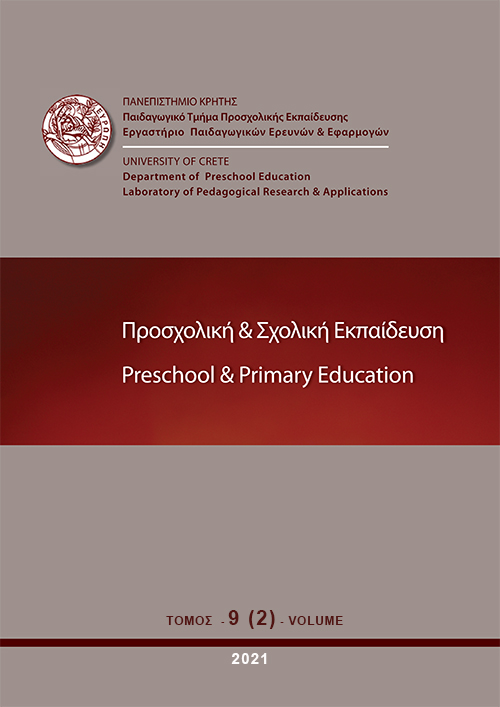Αντιλήψεις γονέων δίγλωσσων παιδιών προσχολικής ηλικίας απέναντι στη διατήρηση της εθνοτικής τους γλώσσας

Περίληψη
Το ζήτημα της διγλωσσίας είναι κάτι που απασχολεί πολλούς μετανάστες γονείς, οι οποίοι ζουν στην Ελλάδα και έχουν παιδιά που φοιτούν σε ελληνικά σχολεία. Η βασική τους ανησυχία είναι η εκμάθηση των ελληνικών, ήδη κατά τη διάρκεια φοίτησης των παιδιών στις τάξεις του νηπιαγωγείου, σε συνδυασμό με την διατήρηση της εθνοτικής τους γλώσσας. Στην παρούσα εργασία διερευνάται η στάση γονέων δίγλωσσων παιδιών προσχολικής ηλικίας, σχετικά με τη διατήρηση της εθνοτικής γλώσσας στην επόμενη γενιά. Η έρευνα βασίζεται σε ημιδομημένες συνεντεύξεις με δεκαπέντε (15) γονείς, που κατάγονται από διάφορες χώρες της Ευρώπης, αλλά και την Αυστραλία. Όπως διαπιστώθηκε από τα ευρήματα της έρευνας, οι περισσότεροι γονείς θέτουν ως βασική προτεραιότητα του οικογενειακού γλωσσικού προγραμματισμού τους την εκμάθηση των ελληνικών, καθώς είναι η γλώσσα καθημερινής επικοινωνίας των παιδιών. Ωστόσο, σχετικά με τη διατήρηση της εθνοτικής γλώσσας στο οικογενειακό περιβάλλον παρατηρούνται διαφοροποιήσεις ανάμεσα στους γονείς, οι οποίες αναλύονται και ερμηνεύονται στην παρούσα εργασία.
Λεπτομέρειες άρθρου
- Πώς να δημιουργήσετε Αναφορές
-
Μαλιγκούδη Χ., & Αραβαντινού-Λιανού Μ. (2021). Αντιλήψεις γονέων δίγλωσσων παιδιών προσχολικής ηλικίας απέναντι στη διατήρηση της εθνοτικής τους γλώσσας. Preschool and Primary Education, 9(2). https://doi.org/10.12681/ppej.25205
- Τεύχος
- Τόμ. 9, Αρ. 2 (2021)
- Ενότητα
- Άρθρα

Αυτή η εργασία είναι αδειοδοτημένη υπό το CC Αναφορά Δημιουργού – Μη Εμπορική Χρήση – Παρόμοια Διανομή 4.0.
Οι συγγραφείς των άρθρων που δημοσιεύονται στο ΠΡΟΣΧΟΛΙΚΗ & ΣΧΟΛΙΚΗ ΕΚΠΑΙΔΕΥΣΗ διατηρούν τα δικαιώματα πνευματικής ιδιοκτησίας επί των άρθρων τους, δίνοντας στο περιοδικό το δικαίωμα της πρώτης δημοσίευσης. Άρθρα που δημοσιεύονται στο ΠΡΟΣΧΟΛΙΚΗ & ΣΧΟΛΙΚΗ ΕΚΠΑΙΔΕΥΣΗ διατίθενται με άδεια Creative Commons 3.0 και σύμφωνα με την άδεια μπορούν να χρησιμοποιούνται ελεύθερα, με αναφορά στο/στη συγγραφέα και στην πρώτη δημοσίευση για μη κερδοσκοπικούς σκοπούς και με δικαίωμα τροποποίησης μόνον με παρόμοια διανομή (αν αναμείξετε, τροποποιήσετε, ή δημιουργήσετε πάνω στο υλικό, πρέπει να διανείμετε τις δικές σας συνεισφορές υπό την ίδια άδεια όπως και το πρωτότυπο). To Εργαστήριο Παιδαγωγικών Ερευνών και Εφαρμογών του Παιδαγωγικού Τμήματος Προσχολικής Εκπαίδευσης του Πανεπιστημίου Κρήτης και το Εθνικό Κέντρο Τεκμηρίωσης διατηρούν το δικαίωμα να δημοσιεύουν, να αναπαραγάγουν, να παρουσιάζουν στο κοινό, να διανέμουν και χρησιμοποιούν άρθρα που δημοσιεύονται στο ΠΡΟΣΧΟΛΙΚΗ & ΣΧΟΛΙΚΗ ΕΚΠΑΙΔΕΥΣΗ σε οποιοδήποτε μέσο και μορφή είτε μεμονωμένα είτε ως μέρη συλλογικών έργων, για όλο το χρόνο διάρκειας προστασίας της πνευματικής ιδιοκτησίας και για όλες τις χώρες του κόσμου. Αυτό περιλαμβάνει ενδεικτικά και όχι αποκλειστικά, το δικαίωμα δημοσίευσης των άρθρων σε τεύχη του περιοδικού ΠΡΟΣΧΟΛΙΚΗ & ΣΧΟΛΙΚΗ ΕΚΠΑΙΔΕΥΣΗ, αναπαραγωγής και διανομής μεμονωμένων αντιγράφων των άρθρων, αναπαραγωγής ολόκληρων των άρθρων σε άλλη έκδοση του Εργαστηρίου Παιδαγωγικών Ερευνών και Εφαρμογών του Παιδαγωγικού Τμήματος Προσχολικής Εκπαίδευσης του Πανεπιστημίου Κρήτης και του Εθνικού Κέντρου Τεκμηρίωσης και αναπαραγωγής και διανομής των άρθρων ή περίληψης αυτών με χρήση πληροφορικού συστήματος αποθετηρίου.


